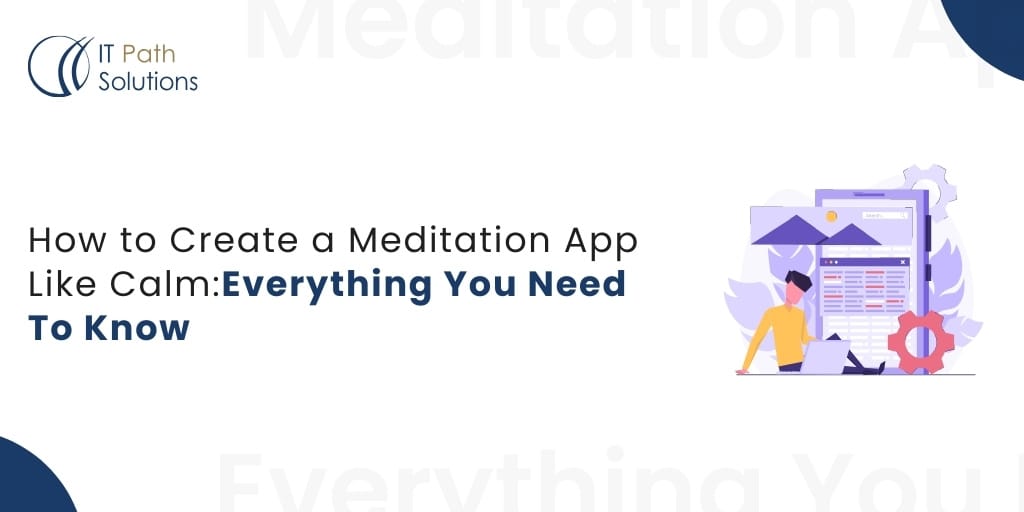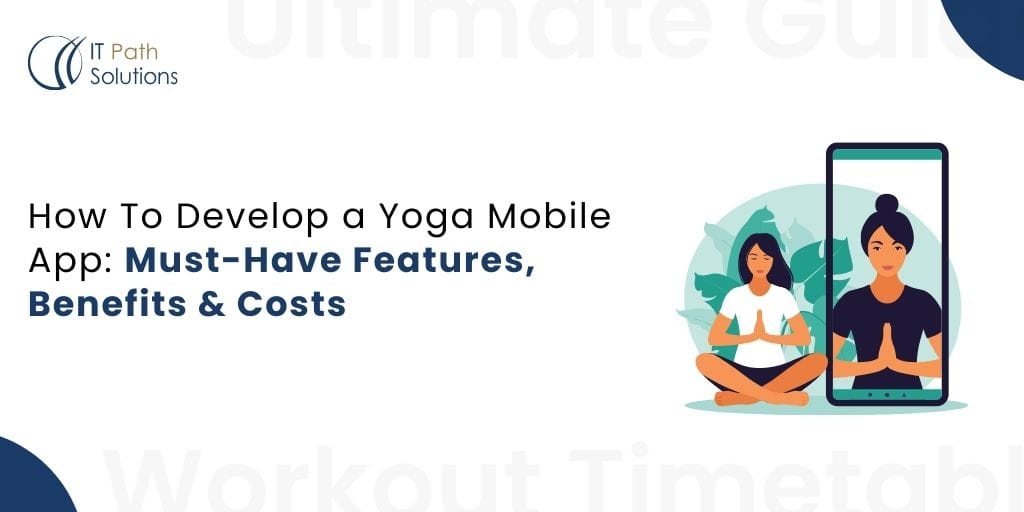How To Build Meditation App Like Calm

Traditionally, people have turned off their mobile phones and traveled to distant locations to escape stress and find peace. However, this approach has taken a huge turn with the rise of mindfulness meditation apps like Calm. These apps have helped individuals realize that smartphones can be more than just a source of distraction—they can be a powerful tool for relaxation and mental well-being.
With the growing demand for mindfulness and relaxation, more than thousands of people are searching for meditation mobile apps to incorporate meditation into their daily lives. As a result, Calm has already touched 3.6 million downloads in Q1 of 2023.
But have you ever wondered, “How to create a meditation app like Calm?“ If so, dive into this blog for a comprehensive guide on Calm-like app development. We’ll explore the complete development process, key features, costs, and more.
Before we get started, let’s take a look at the current mindful meditation app market.
There are the reasons to build a meditation app:
- Meditation app is an on-demand application and it’s growing in the market and profitability too. With An average number of 350 million people practicing meditation worldwide, the market presents a significant opportunity for new apps to gain traction and attract users. If you develop a well-designed and feature-rich meditation app, it won’t go unnoticed.
- Meditation apps can expand their user base by offering more than just meditation. By incorporating features like habit trackers, relaxation music, and sleep practices, your app can cater to a broader audience seeking a holistic wellness experience.
An Overview Into Mindful Meditation App Market
The Calm app is currently on a mission to help people reduce stress and enhance well-being through meditation. Below are some key statistics highlighting the rapid growth of the mindful meditation app market:
- Recently 65% of people are actively searching for yoga and meditation apps to unwind and relax at the end of the day.
- 275 million people worldwide are practicing meditation, reflecting the increasing awareness of mindfulness.
- Leading meditation apps like Calm and Headspace dominate the market, as evident from recent industry trends and data.
These insights showcase the rising demand for meditation apps and their growing influence in promoting mental wellness.
In today’s fast-paced world, digital wellness solutions have become a source of comfort for many seeking relief from stress and depression. During the height of the pandemic, millions turned to meditation apps like Calm to cope with sudden emotional distress.
As a result, Calm has significantly expanded its user base in recent years. If you’re considering developing a mindful meditation app, now is the perfect time to enter this growing market.
But how to create a meditation app like Calm? Here is the comprehensive guide to make a Calm like app for the business .
Read Blog: How To Develop a Meditation App?
How Does Calm App Work?
Calm is a user-friendly meditation app that personalizes recommendations based on users’ responses during registration. It offers over 100 guided sessions to help reduce stress and anxiety, along with an extensive library of sleep stories for better relaxation.
Upon installation, Calm asks users a simple question: “What brings you to Calm?” Users can select from options like improving happiness, reducing anxiety, or enhancing sleep quality. Based on their choice, the app curates a tailored meditation experience. Then users can register on the app and enjoy a 7-day free trial to explore its features. After the trial period, they can choose from various subscription plans.
Interested? Right to make a similar app like Calm!
But,’How to create a meditation app like Calm?’
Then, go ahead with the next section to learn the in-detailed of key features and app development process.
Key features of a meditation app

Sign-up / Sign-in page
A smooth and user-friendly authentication process will allow users to register or log in effortlessly. This feature supports multiple sign-in options, including email, social media accounts, or phone number authentication. A guest mode can also be included for those who want to explore limited features before signing up.
Personal profile
A personalized profile helps users tailor their meditation experience. It includes features like setting meditation goals, tracking progress, and saving favorite sessions. Users can customize their profile settings, choose preferred themes, and manage notification preferences for a more engaging experience.
Meditation library
A diverse meditation library is essential, offering guided sessions, mindfulness exercises, breathing techniques, and relaxation music. The content should be categorized based on themes such as stress relief, sleep, focus, and anxiety management, allowing users to easily find sessions that meet their specific needs.
Play / Stop buttons
Intuitive media controls ensure a seamless user experience. The app should provide easy-to-access play and stop buttons that allow users to start or pause a meditation session without interruptions. Background play functionality can be included so users can continue their meditation while using other apps or locking their device.
Personal progress
Tracking progress helps users stay motivated and committed to their meditation journey. A dedicated section should display key insights, such as the number of completed sessions, streaks, total meditation time, and personalized recommendations based on user activity. This feature encourages consistency and long-term mindfulness habits.
Push notifications
Timely reminders and motivational notifications help users maintain a regular meditation routine. The app should allow users to set customizable reminders for daily practice, receive encouragement messages, and get updates about new meditation sessions or challenges to enhance engagement.
Which tech stack to choose for a meditation app
If you’re looking to create a mindfulness app, choosing the right tech stack is crucial for cost-effective and efficient development. A well-structured tech stack can streamline the process, ensuring a smooth user experience while integrating essential features seamlessly. But which one is the best fit for your project?
A JavaScript-based tech stack is a reliable choice, offering versatility and robust support for various application types. Within this ecosystem, there are three primary frameworks: React JS & Angular JS for web applications, Electron.js for desktop apps, and React Native for mobile development. Each serves a unique purpose, allowing developers to build responsive and scalable solutions.
For those focused on developing a meditation mobile app, React Native is an excellent choice. It enables cross-platform compatibility, reducing development time while maintaining a native-like experience. Its flexibility and efficiency make it a preferred framework for mobile app development.
Saves Time – Using React Native can significantly speed up the development process, allowing you to launch a functional version of your mindfulness app in less than four months. Unlike native development, which requires separate codebases for iOS and Android, React Native enables you to build a single codebase that works across both platforms. With just minor adjustments, your app can be ready for release on the App Store and Google Play, helping you reach a wider audience faster.
Additionally, React Native streamlines feature development by eliminating the need to code everything from scratch. For example, if you want your wellness app to allow users to meditate and track progress even when their phone is locked, you don’t have to develop this feature from the ground up.
React Native provides pre-built libraries and reusable components, enabling developers to integrate essential functionalities quickly. This reduces development time and ensures a faster launch, making it an ideal choice for building a high-quality meditation app efficiently.
How to create a meditation app

Define your business idea
Before diving into design and development, it’s crucial to refine your app concept. A clear business idea defines key development areas and sets the direction for success. Establishing your goals early ensures a more focused and effective app-building process.
Design your meditation app
If your app is designed to support users with stress relief, anxiety management, and mental well-being, a user-friendly interface and thoughtful color selection are essential. Popular meditation apps like Headspace and Calm use a minimalistic design paired with soothing pastel colors. Shades of pastel pink, violet, and green are commonly used to create a calming and relaxing experience.
Develop MVP
Start by selecting the platform for your app: iOS or Android. If your budget allows, consider developing for both platforms. To reduce costs, opt for cross-platform development with frameworks like React Native. Building a Minimum Viable Product (MVP) is a smart approach to test your idea and gather valuable feedback from real users.
Gather feedback and plan the app’s improvement
Once you release your MVP and gather user feedback, it’s time to plan your next steps. Launching the app is just the beginning of your business journey. Continuous improvements and updates are essential to meet user needs and stay competitive.
Final Thoughts
Is it a good idea to develop an app like Calm? Yes, because the meditation app market continues to grow. With rising stress levels in daily life, people actively seek innovative tools to help them relax and improve their mental well-being. Additionally, monetization is straightforward—most competitors successfully use premium subscriptions, making users more open to recurring payments.
When creating a meditation app, a strong concept and a trusted, experienced mobile app development partner matter more than your initial investment. We’d love to help you create an app like Calm—or even better! If you’re looking for full-cycle development, get in touch with us, and we’ll get back to you within 24 hours.
 Healthcare
Healthcare  Education
Education  Real Estate
Real Estate  Logistic
Logistic  Themes
Themes
 Plugins
Plugins
 Patterns
Patterns

